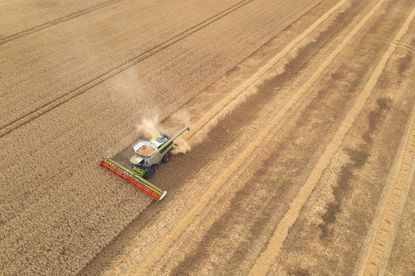How investors can profit from high food prices
The latest furore over grocery prices will die down, says David Stevenson. But the long-term outlook for soft commodities remains bullish. These are the stocks investors can buy to profit from high food prices.

What does the future hold for grocery costs? Here we need to monitor prices of ‘soft’ commodities: agricultural products, essentially.
Softs are among the world’s oldest traded products, though different exchanges classify soft commodities differently. They are traded in futures contracts, like all raw materials; farmers have traditionally used these contacts to lock in crop prices, while in recent decades investors expressing a view on price trends have been using them, too.
Owing to uncertainties such as weather, soft-commodity futures contracts can be volatile. Livestock, cotton, sugar, corn and wheat are classic examples of soft commodities; further examples include meat, livestock, cereals, grains, oilseeds, coffee, cocoa and orange juice.
Subscribe to MoneyWeek
Subscribe to MoneyWeek today and get your first six magazine issues absolutely FREE

Sign up to Money Morning
Don't miss the latest investment and personal finances news, market analysis, plus money-saving tips with our free twice-daily newsletter
Don't miss the latest investment and personal finances news, market analysis, plus money-saving tips with our free twice-daily newsletter
After today’s food price scare has evaporated, then the real soft commodity price problems will start.
Food prices could continue to rise
Granted, Ukraine had harvested 93% of its 2022 expected grain crop as of 6 January 2023. However, the growing area was seriously compromised, yields were down and production was 40% lower than in 2021 as the war keeps hampering farming, according to a statement from Ukraine’s agriculture ministry.
Supplies from the “breadbasket” are more likely to fall than climb. Meanwhile, the US Department of Agriculture’s (USDA) latest biannual report shows that at the start of 2023, the number of US beef cows (those bred for meat sales) had declined to its lowest since 1962.
Overall cattle numbers were at their smallest since 2015. Yet since 1962, the US population has grown by 80%. “There is a pretty substantial lag in the beef supply chain,” says James Mitchell, extension livestock economist at the University of Arkansas. “What consumers experience at the grocery store is a product of what cattle producers were going through a year or two ago. It takes about two years for a new calf to become the steak on your dinner plate.”
This downtrend doesn’t look like likely to reverse in 2023.
Wheat prices could continue to rise
Over to crops: Kansas has been called the US breadbasket, says America’s 12News channel. However, in 2023 “wheat farmers in the state will reap their smallest harvest in more than 60 years. This will go down the chain to consumers at the grocery store.
There are several longer-term threats to global farming, too. Natural disasters such as hurricanes, floods, fires, earthquakes and tornadoes challenge agricultural production, notes the US Environmental Protection Agency (EPA). Such events can cause water contamination, loss of harvests or livestock, increased susceptibility to disease and destruction of irrigation systems and other agricultural infrastructure.
Between 2008 and 2018, billions of dollars were lost owing to crop and livestock output falls following natural disasters, notes the FAO. Losses ranged from $30bn in sub-Saharan and North Africa to $49bn in Asia. Future repeats on this scale could be disastrous.
Then there is urbanisation. In 2022, the US lost 1.9 million acres of farmland, says the USDA’s latest Farms and Land in Farms report. Indeed, since 2015 US farmland acreage has decreased by 12.4 million acres, an average of nearly 1.8 million acres per year.
One of the main reasons is the expansion of cities and towns into once rural areas, and the conversion of farmland into residential, commercial or industrial land uses. None of this bodes well for global food production.
The world could be heading into an era of food insecurity, scarcity and consequent social unrest. We can’t stop this happening, but we can try to protect ourselves and our finances.
The stocks to buy now
The sterling-denominated WisdomTree Agriculture ETC (LSE: AGAP), an exchange-traded commodity fund, provides access to a basket of agricultural commodity futures contracts that track the Bloomberg Agriculture SubIndex. Note, though, that you need to answer a sophisticated investor questionnaire before buying it.
The Barings Global Agriculture Fund has sterling-denominated shares. The fund aims to achieve capital growth by investing in equity and equity-related securities in the agricultural sector. The firms’ activities range “from planting [and] harvesting to delivering food to the table”. The fund focuses on quality and long-term growth potential.
Moving on to individual stocks, Archer Daniels Midland (NYSE: ADM), with a market value of $40bn, is a global leader in human and animal nutrition and the world’s top agricultural processing company. Its work includes developing plant- based proteins and probiotics, and transforming crops into ingredients for foods, beverages and supplements worldwide.
Falls in soft commodity prices have contributed to a recent 25% decline in the stock. Yet ADM produced sales of $102bn and record adjusted earnings per share (EPS) of $7.85 in 2022. The company has also increased its dividend for 50 consecutive years. For 2023, average analysts’ estimates put the stock on a cheap-looking price/ earnings (p/e) ratio of just over ten. The yield is 2.5%. Buy.
Nutrien (Toronto: NTR), a major producer of fertilisers and seeds, helps growers increase food production in a sustainable manner. The company produces and distributes some 25 million tonnes of potash, nitrogen and phosphate products for agricultural, industrial and feed customers worldwide.
While Nutrien expects EPS to drop by around 50% this year, thanks largely to lower fertiliser prices, the shares have discounted this, having halved in 14 months. This leaves NTR on a forward p/e of nine, while the dividend yield is a decent 3.6%. A long-term buy.
-
-
 Investment trust discounts hit 2008 levels. Here’s how to profit
Investment trust discounts hit 2008 levels. Here’s how to profitInvestment trust discounts have risen to levels not seen since 2008, here are three trusts looking to buy to profit.
By Rupert Hargreaves Published
-
 A luxury stock to buy at a high street price
A luxury stock to buy at a high street priceInvestors wrongly consider Watches of Switzerland a high-street outlet.
By Dr Matthew Partridge Published
-
 Investing in wine: how Cru Wine is reaching new audiences
Investing in wine: how Cru Wine is reaching new audiencesTips Gregory Swartberg, founder of fine wine specialist Cru Wine, talks to Chris Carter about how to start a wine collection
By Chris Carter Published
-
 Small companies with big potential
Small companies with big potentialMichael Taylor of Shifting Shares reviews his 2023 picks and highlights more promising minnows.
By Michael Taylor Published
-
 The MoneyWeek portfolio of investment trusts – July 2023 update
The MoneyWeek portfolio of investment trusts – July 2023 updateTips A decade ago we set up the MoneyWeek portfolio of investment trusts. They remain a compelling long-term bet says Rupert Hargreaves
By Rupert Hargreaves Published
-
 Women lead the way with ethical investments
Women lead the way with ethical investmentsDemand for more ethical investments has soared – and women are more likely to opt for them. Annabelle Williams, personal finance specialist at Nutmeg, takes a look at why.
By Annabelle Williams Published
-
 BoE: Mortgage payments to rise by £220 a month for households
BoE: Mortgage payments to rise by £220 a month for householdsMillions of households can expect a mortgage spike of around £200 a month - and some may even reach a extra £1,000 a month, the Bank of England warns
By Marc Shoffman Published
-
 What happened to Thames Water?
What happened to Thames Water?Thames Water, the UK’s biggest water company could go under due to mismanagement and debt. We look into how the company got itself into this position, and what investors should expect.
By Simon Wilson Last updated
-
 Where to invest in the metals that will engineer the energy transition
Where to invest in the metals that will engineer the energy transitionA professional investor tells us where he’d put his money. This week: John Ciampaglia, manager of the Sprott Energy Transition Materials UCITS ETF.
By Nicole García Mérida Published
-
 The outlook for stocks is improving
The outlook for stocks is improvingThis is the best of times for investors, says Max King. Global risks are receding, but few have noticed.
By Max King Published









